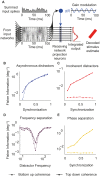Efficient "communication through coherence" requires oscillations structured to minimize interference between signals
- PMID: 23144603
- PMCID: PMC3493486
- DOI: 10.1371/journal.pcbi.1002760
Efficient "communication through coherence" requires oscillations structured to minimize interference between signals
Abstract
The 'communication through coherence' (CTC) hypothesis proposes that selective communication among neural networks is achieved by coherence between firing rate oscillation in a sending region and gain modulation in a receiving region. Although this hypothesis has stimulated extensive work, it remains unclear whether the mechanism can in principle allow reliable and selective information transfer. Here we use a simple mathematical model to investigate how accurately coherent gain modulation can filter a population-coded target signal from task-irrelevant distracting inputs. We show that selective communication can indeed be achieved, although the structure of oscillatory activity in the target and distracting networks must satisfy certain previously unrecognized constraints. Firstly, the target input must be differentiated from distractors by the amplitude, phase or frequency of its oscillatory modulation. When distracting inputs oscillate incoherently in the same frequency band as the target, communication accuracy is severely degraded because of varying overlap between the firing rate oscillations of distracting inputs and the gain modulation in the receiving region. Secondly, the oscillatory modulation of the target input must be strong in order to achieve a high signal-to-noise ratio relative to stochastic spiking of individual neurons. Thus, whilst providing a quantitative demonstration of the power of coherent oscillatory gain modulation to flexibly control information flow, our results identify constraints imposed by the need to avoid interference between signals, and reveal a likely organizing principle for the structure of neural oscillations in the brain.
Conflict of interest statement
The authors have declared that no competing interests exist.
Figures






References
-
- Jones MW, Wilson MA (2005) Theta Rhythms Coordinate Hippocampal–Prefrontal Interactions in a Spatial Memory Task. PLoS Biol 3: e402 doi:10.1371/journal.pbio.0030402. - DOI - PMC - PubMed
-
- Salinas E, Sejnowski TJ (2001) Correlated neuronal activity and the flow of neural information. Nat Rev Neurosci 2: 539–550 doi:10.1038/35086012. - DOI - PMC - PubMed
-
- Fries P (2005) A mechanism for cognitive dynamics: neuronal communication through neuronal coherence. Trends Cogn Sci 9: 474–480. - PubMed
Publication types
MeSH terms
Grants and funding
LinkOut - more resources
Full Text Sources

